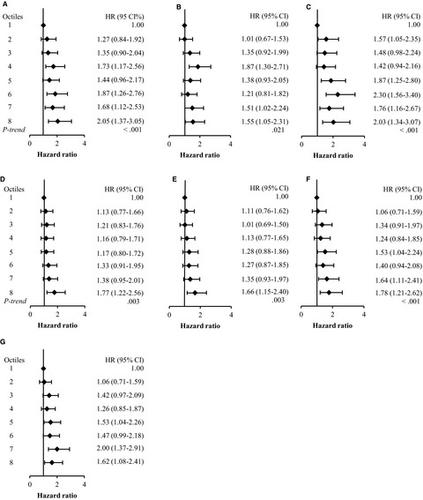当前位置:
X-MOL 学术
›
Cancer Med.
›
论文详情
Our official English website, www.x-mol.net, welcomes your
feedback! (Note: you will need to create a separate account there.)
The association between DXA-derived body fat measures and breast cancer risk among postmenopausal women in the Women's Health Initiative.
Cancer Medicine ( IF 2.9 ) Pub Date : 2019-12-25 , DOI: 10.1002/cam4.2690 Rhonda S Arthur 1 , Xiaonan Xue 1 , Victor Kamensky 1 , Rowan T Chlebowski 2 , Michael Simon 3 , Juhua Luo 4 , Aladdin H Shadyab 5 , Marian L Neuhouser 6 , Hailey Banack 7 , Gloria Y F Ho 8 , Dorothy S Lane 9 , Kathy Pan 2 , Kerryn W Reding 10 , Sylvia Wassertheil-Smoller 1 , Andrew J Dannenberg 11 , Thomas E Rohan 1
Cancer Medicine ( IF 2.9 ) Pub Date : 2019-12-25 , DOI: 10.1002/cam4.2690 Rhonda S Arthur 1 , Xiaonan Xue 1 , Victor Kamensky 1 , Rowan T Chlebowski 2 , Michael Simon 3 , Juhua Luo 4 , Aladdin H Shadyab 5 , Marian L Neuhouser 6 , Hailey Banack 7 , Gloria Y F Ho 8 , Dorothy S Lane 9 , Kathy Pan 2 , Kerryn W Reding 10 , Sylvia Wassertheil-Smoller 1 , Andrew J Dannenberg 11 , Thomas E Rohan 1
Affiliation

|
BACKGROUND
Most studies demonstrating an association between excess adiposity and postmenopausal breast cancer have used anthropometric measures, particularly body mass index (BMI). However, more direct body fat measures may more accurately determine the relationship between body fat distribution and breast cancer risk.
METHODS
Cox proportional hazards regression models were created to examine the associations of dual-energy x-ray absorptiometry (DXA) body fat measures (at baseline and during follow-up) with breast cancer risk among 10 931 postmenopausal women from the Women's Health Initiative cohort. A total of 639 incident invasive breast cancer cases (including 484 estrogen receptor positive (ER+) cases) were ascertained after a median follow-up of 15.0 years.
RESULTS
Excess whole body fat mass and trunk fat mass were positively associated with risk invasive breast cancer risk. These associations persisted even after additional adjustment for standard anthropometric measures. In time-dependent analyses, we observed that both whole body fat mass and trunk fat mass, in the highest versus lowest category, were associated with a doubling of risk of invasive breast cancer overall (HR: 2.17; 95% CI: 1.54-3.05 and 2.20; 1.55-3.14, respectively) and of ER+ breast cancer (2.05; 1.37-3.05 and 2.03; 1.34-3.07, respectively). The remaining DXA measures were also positively associated with breast cancer risk in baseline and time-dependent analyses.
CONCLUSION
These findings suggest that DXA-derived body fat measures are positively associated with breast cancer risk after adjustment for BMI and other conventional breast cancer risk factors.
中文翻译:

在《妇女健康倡议》中,绝经后妇女中DXA衍生的体脂测量值与乳腺癌风险之间的关系。
背景技术大多数证明肥胖症与绝经后乳腺癌之间存在关联的研究都使用了人体测量学方法,尤其是体重指数(BMI)。但是,更直接的体内脂肪测量可能会更准确地确定体内脂肪分布与乳腺癌风险之间的关系。方法创建了Cox比例风险回归模型,以检查妇女健康倡议队列中10 931名绝经后妇女中双能X线骨密度仪(DXA)体脂测量(基线和随访期间)与乳腺癌风险的相关性。在中位随访15.0年后,总共确定了639例侵袭性乳腺癌事件(包括484个雌激素受体阳性(ER +)病例)。结果全身脂肪过多和躯干脂肪过多与浸润性乳腺癌风险呈正相关。即使对标准人体测量学进行了额外的调整,这些关联仍然存在。在时间依赖性分析中,我们观察到最高和最低类别的全身脂肪量和躯干脂肪量都与整体浸润性乳腺癌风险加倍相关(HR:2.17; 95%CI:1.54-3.05和分别为2.20、1.55-3.14和ER +乳腺癌(分别为2.05、1.37-3.05和2.03、1.34-3.07)。在基线和时间依赖性分析中,其余的DXA测量值也与乳腺癌风险呈正相关。
更新日期:2019-12-26
中文翻译:

在《妇女健康倡议》中,绝经后妇女中DXA衍生的体脂测量值与乳腺癌风险之间的关系。
背景技术大多数证明肥胖症与绝经后乳腺癌之间存在关联的研究都使用了人体测量学方法,尤其是体重指数(BMI)。但是,更直接的体内脂肪测量可能会更准确地确定体内脂肪分布与乳腺癌风险之间的关系。方法创建了Cox比例风险回归模型,以检查妇女健康倡议队列中10 931名绝经后妇女中双能X线骨密度仪(DXA)体脂测量(基线和随访期间)与乳腺癌风险的相关性。在中位随访15.0年后,总共确定了639例侵袭性乳腺癌事件(包括484个雌激素受体阳性(ER +)病例)。结果全身脂肪过多和躯干脂肪过多与浸润性乳腺癌风险呈正相关。即使对标准人体测量学进行了额外的调整,这些关联仍然存在。在时间依赖性分析中,我们观察到最高和最低类别的全身脂肪量和躯干脂肪量都与整体浸润性乳腺癌风险加倍相关(HR:2.17; 95%CI:1.54-3.05和分别为2.20、1.55-3.14和ER +乳腺癌(分别为2.05、1.37-3.05和2.03、1.34-3.07)。在基线和时间依赖性分析中,其余的DXA测量值也与乳腺癌风险呈正相关。











































 京公网安备 11010802027423号
京公网安备 11010802027423号